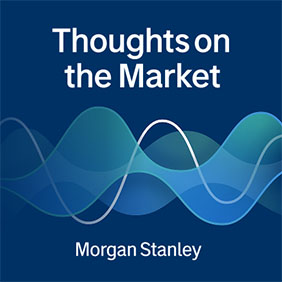Can the Fed’s Move Boost Global Credit?
September 19, 2025
With this week’s announcement of a rate cut and further cuts in the offing, the Fed seems willing to let the U.S. economy run a little hot. Our Head of Corporate Credit explain why this could give an unexpected boost to the European bond market.

-
 Andrew Sheets
Andrew Sheets
Thoughts on the Market
Listen to our financial podcast, featuring perspectives from leaders within Morgan Stanley and their perspectives on the forces shaping markets today.

Up Next
Why a Fed Pivot Could Trigger Volatility
Transcript
Welcome to Thoughts on the Market. I'm Michael Zezas, Global Head of Fixed Income Research and Public Policy Strategy.
Today: What a subtle shift in the Fed’s reaction function could mean for markets into year-end.
It’s Wednesday, September 3rd at 11am in New York.
Last week, our U.S. economics team flagged a subtle but important shift in U.S. monetary policy. Chair Jay Powell’s speech at Jackson Hole underscored that the Fed looks more focused on managing downside growth risks and, consequently, a bit more tolerant on inflation.
As you heard Michael Gapen and Matthew Hornbach discuss last week – our colleagues expect this brings forward another Fed cut into September, kicking off a quarterly pace of 25 basis-point moves. But while this is a meaningful change in the timing of Fed rate cuts, this path would only result in slightly lower policy rates than those implied by the futures market, a proxy for the consensus of investors.
So what does it mean for our views across asset classes? In short, our central case is for mostly positive returns across fixed income and equities into year-end. But the Fed’s increased tolerance for inflation is a new wrinkle that means investors are likely to experience more volatility along the way.
Consider U.S. government bonds. A slower economy and falling policy rates argue for lower Treasury yields. But if investors grow more convinced that the Fed will tolerate firmer inflation, the curve could steepen further, with the risk of longer maturity yields falling less, or potentially even rising.
Or consider corporate bonds. Our economic growth view is “slower but still expanding,” which generally bodes well for corporate balance sheets and, thus, the pricing of credit risk. That combined with lower front-end rates suggests a solid total return outlook for corporate credit, keeping us constructive on the asset class. But of course, if long end yields are moving higher, it would certainly cut against overall returns potential.
Finally, consider the stock market. The base case is still constructive into year-end as U.S. earnings hold firm, and recent tax cuts should further help corporate cash flows. However, if long bonds sell off, this could put the rally at risk – at least temporarily, as my colleague Mike Wilson has highlighted; given that higher long-end yields are a challenge to the valuation of growth stocks.
The risk? A repeat of the early-April dynamic where a long-end sell-off pressures valuations.
Could we count on a shift in monetary policy to curb these risks? Or another public policy shift such as easing tariffs or Treasury adjusting its bond issuance plans? Possibly. But investors should understand this would be a reaction to market conditions, not a proactive or preventative shift.
So bottom line, we still see many core markets set up to perform well, but the sailing should be less smooth than it has been in recent months.
Thanks for listening. If you enjoy Thoughts on the Market, please leave us a review and tell your friends about the podcast. We want everyone to listen.

Are Agency Mortgage-Backed Securities Making a Comeback?
Transcript
Jay Bacow: Welcome to Thoughts on the Market. I'm Jay Bacow, Co-Head of Securitized Products Research at Morgan Stanley.
James Egan: And I'm Jim Egan, the other Co-Head of Securitized Products Research at Morgan Stanley.
Jay Bacow: Today we're here to talk about why mortgages offer value after Jackson Hole.
It's Tuesday, September 2nd at 2pm in New York.
James Egan: So, Jay, let's start with the big picture after Jackson Hole, the Fed seems like it's leaning towards cutting rates in a steady, almost programmatic fashion. And in prior episodes of Thoughts on the Market, you've heard different strategists at Morgan Stanley talk about the potential implications there.
But for mortgages, what does this mean?
Jay Bacow: Well, it takes a lot of the uncertainty out of the market, and that's a big deal. One of the worst-case scenarios[s] for agency mortgages – that the investors are buying not mortgages that homeowners have – would've been the Fed staying on hold for much longer than expected. With that risk receding, the backdrop for investors owning agency mortgages feels a lot more supportive. And when we look at high quality assets, we think mortgages look like the cheapest option.
Jim, you mentioned some of the previous strategists that come on Thoughts on the Market. Our Global Head of Corporate Credit Strategy, Andrew Sheets had highlighted recently how credit spreads are trading at basically the tights of the past 20 years. Mortgages are basically at the average level of the past 20 years. It seems attractive to us.
James Egan: And that relative value really does matter. Investors are looking for places to earn yield without taking on too much credit risk. Mortgages, particularly agency mortgages with government guarantee there, they offer that balance.
Jay Bacow: Right. And it's not just that balance, but when we think about what goes into the asset pricing, the supply and demand picture makes a big difference. And that we think is changing. One of the reasons that mortgages have underperformed corporate credit is that when you look at the composition of the buyers, the two largest holders of mortgages are the Fed and domestic banks.
The Fed's obviously going to continue to run their portfolio down, but domestic banks have also been on the sidelines. And that's meant that money managers, and to a lesser extent overseas, have had to be the largest buyers. But we think that could change.
James Egan: Right, with more clarity on Fed policy, banks in particular may get more comfortable adding mortgages to their balance sheets, though the exact timing depends on regulatory developments. REITs might also find this more compelling?
Jay Bacow: Right. If the Fed's cutting rates, the front end is going to be lower, and that's going to mean that the incentive to move out of cash should be higher, and that's going to help both banks and likely REITs. But then there's also the supply side.
Net issuance of conventional mortgage has been negative this year. That's obviously good. And some of the other technicals are improving as well. Vols are trading better, and all of this just contributes to a healthier landscape.
James Egan: Right. And another thing that we've talked about when discussing mortgage valuations is the importance of volatility. If you're buying mortgages, you're inherently short rate volatility – and volatility has come down meaningfully since last year, even if it's still above pre-COVID norms. Lower volatility supported for mortgage valuations, especially when paired with a Fed that's cutting rates steadily. Though Jay, some of that already in the price?
Jay Bacow: Yeah, look. We didn't say mortgages were cheap. We just said mortgages are trading at the long-term averages. But in an environment where stocks are near the all time high and credits near the tights of the past 20 years, we do see that value. And the Fed cutting rates, as we said, should incentivize investors to move out of cash and into securities.
Now, there are risks when valuations and other asset classes are as tight or as high as they are. You could see risk assets broadly underperform and mortgages are a risk asset. So, if credit widens, mortgages would not be immune.
James Egan: And timing is important here too, right? Especially we think about banks coming back if they wait for full clarity on Basel III proposals – that could be delayed. On top of that, there's prepayment risk…
Jay Bacow: Yeah, if rates rally, then speeds could pick up and investors are going to demand more compensation. But summing it up. Mortgages look wide to alternative asset classes. The demand picture we think is going to improve, and more clarity around the Fed's path is going to be supportive as well. All of that we think makes us feel confident this is an environment that mortgages should do well. It's not about a snap tighter and spread, it's more about getting paid carry in an environment where spreads can grind in over time.
But Jim, we like mortgages. It's been a pleasure talking to you.
James Egan: Pleasure talking to you too, Jay, and to all of you regularly hearing us out. Thank you for listening to another episode of Thoughts on the Market. Please leave a review or a like wherever you get this podcast and share Thoughts on the Market with a friend or colleague today.
Jay Bacow: Go smash that subscribe button.

Sign up to get Morgan Stanley Ideas delivered to your inbox.
Thank You for Subscribing!
Would you like to help us improve our coverage of topics that might interest you? Tell us about yourself.



